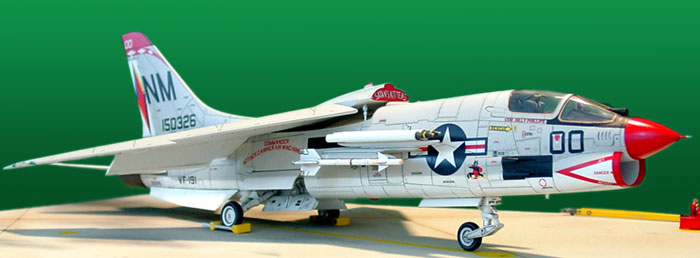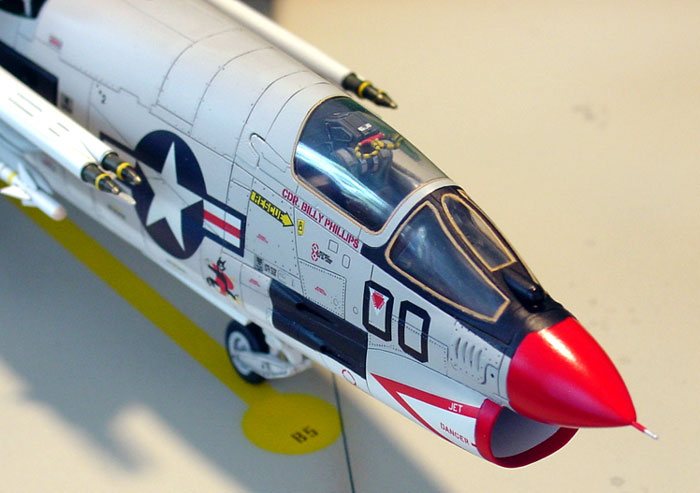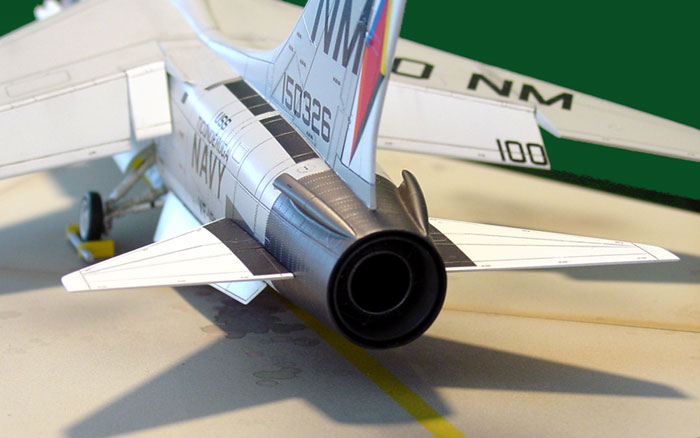|
F-8E Crusader
by
Mark A. Sindiong
|

|
|
F-8E Crusader |

Hasegawa's 1/48
scale F-8E Crusader may be ordered online from
Squadron.com
Here is Hasegawaís new 1/48 scale F-8E Crusader.
After roughly 20 hours of work over a week and a half, Iíve finally
finished this new kit. The model was built 99.8% box stock with the only
exception being the addition of two AIM-9s stolen from a Hasegawa weapon
set (no air to air ordinance is included in the kit).
Why did I decide to build this straight out of the box? Primarily, to
enter it in our local IPMS chapterís box stock night and I was anxious
to see how the kit went together. Well, all I can say is that it went
together!
The kit was pretty straight forward, but there are many small fit
issues, just about all of which had been covered here on Hyperscaleís
Plane Talking discussion group.
The cockpit was assembled and painted and all the other interior parts
attached then sandwiched between the two fuselage halves. There were not
fit problems encountered there. One note - make sure you remember to put
all the poly caps in place per the instructions.

The wing was then assembled and the flaps animated in their lowered
position. There was a slight problem with the fit of the leading edge
flaps in their lowered position. A little sanding corrected this
quickly. Again remember the poly caps, this time inside the wing. The
wing was then attached to the fuselage so I could get an idea of what
the aircraft looked like with the wing in the raised position and thatís
when I discovered the next fit issue. The flaps actually contact the
fuselage with the wings raised and the flaps lowered. It took quite a
bit of sanding to correct this, but luckily it doesnít appear to be that
noticeable and the shape of the flaps had not been changed. Iím pretty
sure that this is actually a fit issue with the kit and not something I
screwed up. But who knows, it may just be my building skillsÖ
The rest of the kit went together pretty well, but hereís a quick list
of some of the other quirks I discovered over the build:
-
The ejection seat interfered with the
canopy and required sanding to allow the canopy to close. (Maybe my
mistake.)
-
Ejector pin marks. Several located on the
model, many of which can easily be seen on the built up kit. Both the
outboard leading edge flaps and outer portions of the pylons suffer from
large ejector pin marks.
-
Burner can and augmenter. Both need to be
sanded to achieve a flush fit of the jet exhaust area.
-
Somewhat weak panel lines on the belly of
the fuselage and misalignment on many of the Zuni warheads (really poor
molding on a couple of them).
-
Frosty canopy that required a lot of
polishing (at least in this kit).
Thatís pretty much it for the areas of irritation I encountered.
There were a few others but most of which have been covered on the
discussion group.

I corrected a few of the small quirks, but didnít mess with opening
the canopy. I am saving that for my next Crusader project.
Moving to painting, I took a different approach to what I normally
do. I didnít have Model Master colors for the exterior and decided to
prime and paint the model using Gunze lacquers. Both the gull grey and
white were thinned at approximated 60% thinner to 40% paint. This
provided me with a really smooth durable finish that dried extremely
fast. The paints were applied using my Thayer & Chandler Vega 2000
airbrush (gravity feed). Detail parts were painted with Model Master
enamels and Alcad II metallic lacquers.

Once the primary colors and detail colors were complete, the decals
were added.
Decaling the kit was straight forward using the kits decals. This time I
used some additional Gunze products and achieved some really nice
results. Before I placed the decal in its spot, I coated the respected
area with Gunze Mr. Decal set and then followed up with Mr. Mark Softer
to get the decals to conform to the model surface. Iím not sure if it
was just dumb luck or if Mr. Decal set is some kind of amazing product,
but there was absolutely no silvering once this process was complete.
Iím sold on these Gunze products.
Next was weathering, the final step for this model. Again I used another
different technique, one I never tried before. I tried the technique
described by Mr. Paul Boyer called a ďsludge washĒ. I ended up using
some Testers Model Master acrylics, thinned with water and a few drops
of dishwashing detergent. The sludge was then added to the models panel
lines with a small brush section by section. This wash dries very
quickly, so you have to be fast in wiping it away before it really sets
up. I was really happy with the effect, but I didnít take Mr. Boyerís
advice on the colors to use. In his Fine Scale article he suggests a
medium gray and I used gunship gray, far to dark for this paint scheme.
Oh well, I screwed up and will use the lighter gray on my next similar
project.
Thatís pretty much it for the kit. I created a very simple generic base
to place the model on. I neglected to mention the additional weathering
with some pastel chalks, but really didnít do too much of that. I wanted
to keep the aircraft relatively clean representing the CAGs aircraft
parked on a navel air station ramp.
Even with some of the fit issues and possible accuracy issues (most
of which I have no clue of), I found this kit still enjoyable to build
and quite convincing as an F-8 Crusader.

I am looking forward to building several more in some of the fancy
liveries these aircraft flew in.
Mahalo Nui Loa!
Click on the thumbnails
below to view larger images:
Model, Images and Text Copyright © 2003 by
Mark A. Sindiong
Page Created 24 February, 2003
Last Updated 17 March, 2004
Back to HyperScale
Main Page
|
Home |
What's New |
Features |
Gallery |
Reviews |
Reference |
Forum |
Search